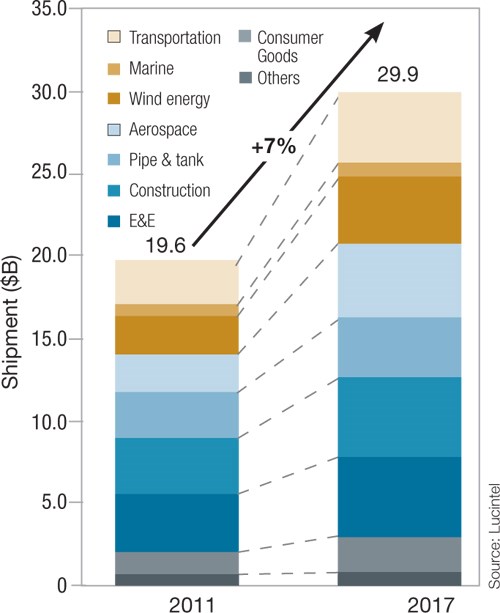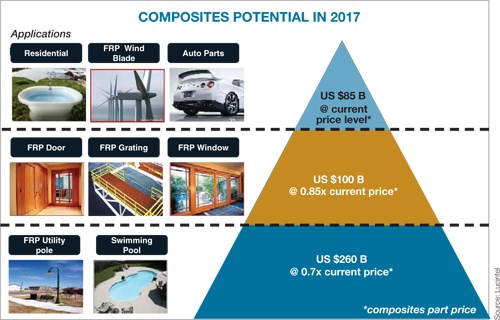Growth opportunities: Materials innovation will drive composites usage to new heights
Dr. Sanjay Mazumdar of Lucintel (Dallas, Texas) predicts double-digit growth for the composites market in the next five years.
Composite materials usage is rising as manufacturers in different industries increasingly adopt this versatile material. Today composites are used in wind energy, marine, construction, aerospace, military/defense, automotive, sporting goods, pipes, tanks and many more applications. Composites offer several advantages over traditional materials: higher tensile strength, lighter weight, greater corrosion resistance, better surface finish and easy processing.
Although they are more expensive than traditional materials, such as aluminum, steel, concrete and wood, composites are making inroads into applications where corrosion resistance, weight savings, fuel savings and other performance benefits are critical.
In 2011, the global composite materials market represented $19.6 billion (USD) in terms of shipment value and recorded 14.3 billion lb/6.486 million metric tonnes in terms of volume. Lucintel forecasts that the value of the global composite materials market will reach an estimated $29.9 billion in 2017, with a compound annual growth rate (CAGR) of 7 percent. The global composites market, in most sectors, is still recovering from the economic downturn of 2008 and 2009.
The advanced composites market accounted for less than $2 billion in 2011, but it is expected to witness double-digit growth through 2017 because of growing demand in the aerospace, defense, transportation and wind energy markets.
Significant growth in the aerospace industry is expected, due to the increasing penetration of advanced composites into commercial aircraft, such as the Boeing 787, the Airbus A350 XWB and the market’s increasing demand for weight reduction. In the wind energy market, ever-larger turbine capacities and increases in average blade length that require lighter and stiffer materials are driving the growth of advanced composites.
The composites industry is expected to witness maximum growth in developing nations such as India, China, Russia and Brazil, where the gross domestic product (GDP) per capita is still small and has much room to improve. New demands for personal transportation in emerging economies are resulting in significant growth in global automotive and infrastructure markets.
Key requirements for the automotive industry include reducing weight and increasing efficiency, which are driving the demand for carbon composites in automobile manufacturing. Carbon composites are used in automotive parts, such as chassis, hoods, roof panels, insulating panels, casing, fenders, mufflers and spoilers.
The market for end-products made of composites was estimated at $55 billion in 2011. This market is forecast to approach $85 billion during 2017.
There are several unmet needs in various segments of the composites industry. Material suppliers and part fabricators need to work together to drive innovations in the composites industry to meet the end-markets’ needs. Some of the areas where the composites industry can drive innovations include sustainability, weight reduction, price reduction and cycle-time reduction. Developing products to meet unfulfilled needs would boost the composites industry to future growth. Reducing the cost of composite products by 30 percent, for example, would increase the composites opportunity to $260 billion in 2017, up dramatically from the forecast of $85 billion.
Sustainability is an important topic in many segments of the composites industry. Automobile manufacturers have invested significant time and money in researching and developing hybrid and electric vehicles that emit fewer pollutants into the environment. In 2013, BMW will introduce its i3 and i8 commuter vehicles, its volume-production electric cars with passenger cells made from carbon fiber-reinforced plastic (CFRP). The new vehicle architecture enables new production processes, which are both simpler and more flexible, and they use less energy.
CFRP is roughly 50 percent lighter than steel and approximately 30 percent lighter than aluminum. The material’s low weight will contribute to the fuel efficiency of BMW’s new vehicles. The i3, for example, will be 750 lb/340 kg lighter than electric vehicles of comparable size. In other words, it will achieve better mileage per kilowatt hour of stored battery power. There is also growing interest in the use of bio-resins and natural fibers in the automotive industry to address sustainability issues.
Related Content
A new era for ceramic matrix composites
CMC is expanding, with new fiber production in Europe, faster processes and higher temperature materials enabling applications for industry, hypersonics and New Space.
Read MoreWelding is not bonding
Discussion of the issues in our understanding of thermoplastic composite welded structures and certification of the latest materials and welding technologies for future airframes.
Read MorePlant tour: Spirit AeroSystems, Belfast, Northern Ireland, U.K.
Purpose-built facility employs resin transfer infusion (RTI) and assembly technology to manufacture today’s composite A220 wings, and prepares for future new programs and production ramp-ups.
Read MoreManufacturing the MFFD thermoplastic composite fuselage
Demonstrator’s upper, lower shells and assembly prove materials and new processes for lighter, cheaper and more sustainable high-rate future aircraft.
Read MoreRead Next
Plant tour: Daher Shap’in TechCenter and composites production plant, Saint-Aignan-de-Grandlieu, France
Co-located R&D and production advance OOA thermosets, thermoplastics, welding, recycling and digital technologies for faster processing and certification of lighter, more sustainable composites.
Read MoreDeveloping bonded composite repair for ships, offshore units
Bureau Veritas and industry partners issue guidelines and pave the way for certification via StrengthBond Offshore project.
Read More“Structured air” TPS safeguards composite structures
Powered by an 85% air/15% pure polyimide aerogel, Blueshift’s novel material system protects structures during transient thermal events from -200°C to beyond 2400°C for rockets, battery boxes and more.
Read More











.jpg;maxWidth=300;quality=90)










